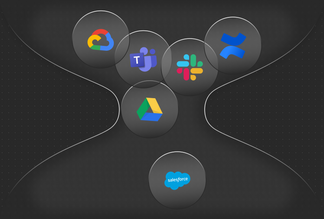

How to eliminate workplace silos
Workplace silos harm the way your teams function, restrict their access to knowledge, fuel internal conflict, and can even weaken customer experiences.
When silos exist, teams don’t just have a hard time finding the information they need, but they also lack the context they need to make informed decisions and move work forward. So, breaking down silos in the workplace is vital, and the way to do it is by promoting trust and transparency—which might involve making a few changes to how your business operates.
Let’s explore the root causes of silos, some telltale signs that they exist, and some possible solutions in more detail.
What are the root causes of your organizational silos?
There are usually a few reasons that silos form, including:
- Misaligned leadership. When your leadership team has conflicting opinions, there's a ripple effect that feeds department and team silos. If teams aren't given a clear path forward, it's natural for them to branch in different directions. If sales and marketing aren't on the same page about business objectives, their activities—and the information they acquire, create, and share—won't be aligned. If your teams are pursuing different goals, not only will departmental silos arise, but knowledge silos become worse, too.
- SaaS sprawl. SaaS sprawl is when organizations build up large tool stacks without thinking about the bigger picture, and it often happens when each team or department chooses their own set of tools. Using too many apps scatters knowledge across them, making it difficult for other teams to find important information. This can lead to slow decisions—or bad ones—because people lack context around the decisions they’re making. There’s a good chance that you’ll also need to train team members to use these products, since specialized SaaS tools typically require education, onboarding, and licensing. So, they can be time-consuming, too.
- A lack of well-defined processes. Does your organization have clearly defined processes for managing access to different platforms, storing information, sharing knowledge, onboarding new hires, and transferring responsibilities when someone leaves? If not, then information silos may arise naturally. As your organization grows, you’ll have more people storing and managing knowledge in an unstructured way. Information might get buried in different apps, and your team members won’t be able to see how their colleagues are working.
What are some of the signs of organizational silos?
If you’re wondering whether your workplace is siloed, look out for the following signs:
- Lack of cross-functional collaboration - Your departments or teams work independently of one another, with minimal collaboration or knowledge sharing. PwC’s research found that more than 55% of companies are working this way, and 61% of them agree that collaboration between departments is key to fulfilling their strategic goals.
- No centralized platforms for collaboration - Different teams rely on different platforms for communication, collaboration, and project and knowledge management. Knowledge workers report losing up to 20 hours a month when they rely on tools that aren’t centralized or integrated across their organization.
- No shared goals - Departments can prioritize different goals and start to have different work cultures. This lack of visibility and transparency can mean that teams stop trusting each other.
Breaking down workplace silos by enhancing transparency, visibility, and context
You can break down silos in your workplace by changing how your organization manages knowledge, improving how it collaborates and communicates, and influencing your internal culture. Here's how to promote transparency, visibility, and context.
First, align your teams with unified company goals
Don't risk dividing your teams by giving them conflicting viewpoints. Instead, make sure your leadership and management teams are aligned on business goals before communicating them to your departments and teams. Then, make sure your organization has a process in place to help teams understand how their daily work drives these goals forward.
OKRs (objectives and key results) can be a great way to tie everyday work to overarching company goals. But only if you specify behaviors and tasks that tie into broader company goals. It's also important to avoid falling into the trap of reviewing OKRs a week before your quarterly review meeting. Instead, commit to reviewing and managing them much more regularly.
Second, simplify your tool stack
While software tools should make it easier for us to manage and find information, our research with Cornell University found that employees spend an average of five hours a week trying to find information inside apps. And 55% of people indicated that it's difficult to get information from other departments that use different apps, meaning SaaS sprawl can also deepen your departmental silos.
So, if you want to increase visibility and transparency, fixing your SaaS sprawl is a good place to start. The goal is to make it easier for people to access, store, and share knowledge. You can decrease how many apps your organization uses by conducting a tool audit and talking to team members to identify tools that they don't really need, or use. You can also radically simplify your tool stack by using a Work Hub to centralize knowledge management, which brings us to…
Third, create a single source of truth
A Work Hub is a living knowledge management system, where information is constantly updated as people work. It breaks down information silos by making it easy for anyone in your organization to get more context.
For example, because your information is connected, someone from sales can easily see which account a marketing campaign is for, and someone from the dev team can quickly see which project a particular file is related to. Having context increases the visibility that your teams have into each other's work, building trust and encouraging them to collaborate more.
Fourth, focus on culture and accountability
Unifying your organization around common goals, simplifying your tool stack, and creating a single source of truth go a long way in increasing visibility. But you still need to cultivate a culture of collaboration, knowledge sharing, and accountability. To an extent, this means creating a documentation culture—one that encourages people to store, manage, update, and share knowledge consistently. You need to be clear about who's responsible for documenting what, and where and when they should record information.
People need to be accountable for more than just the way they store knowledge, though. They also need to take ownership of how they share information, too. One way to do this is by making certain people responsible for information that concerns their area of business. This can work, but it might mean some people don’t think they need to do anything at all. That’s why another good option is to build it into everyone’s objectives and their performance management process, so that the whole organization is responsible.
The bottom line
Breaking down silos in the workplace doesn’t happen overnight — it takes time, patience, and a commitment to improving the way your organization communicates and shares knowledge. You’ll need to align your teams around common goals, make it easy for them to collaborate, and empower your people with the tools they need to succeed.
A Work Hub is a great place to start. Instead of having different teams store information on different platforms, a Work Hub centralizes knowledge in one place. Qatalog helps you do this by providing you with a structured, scalable Work Hub that reflects the way your business works.
To find out how Qatalog can promote visibility, transparency, and context in your organization, book a demo with one of our team today.


